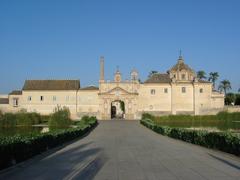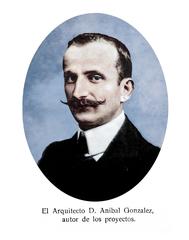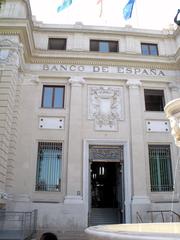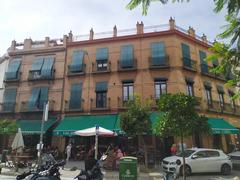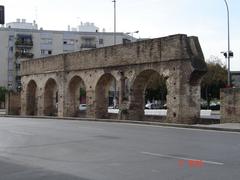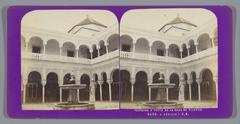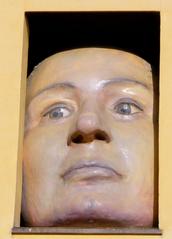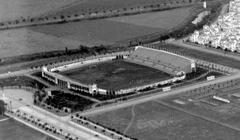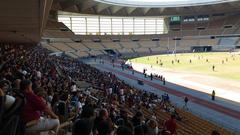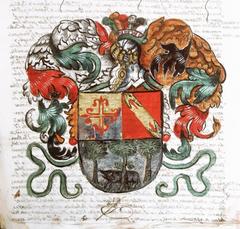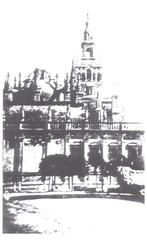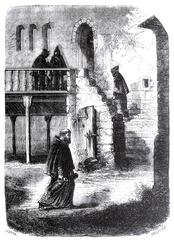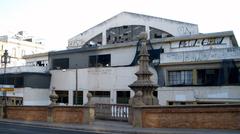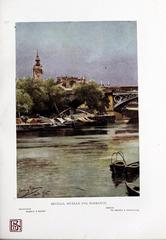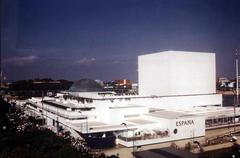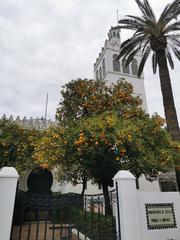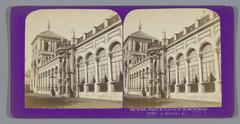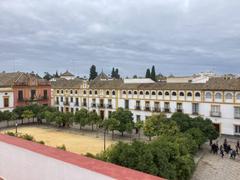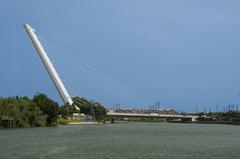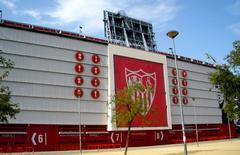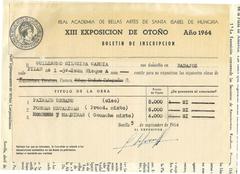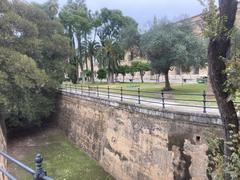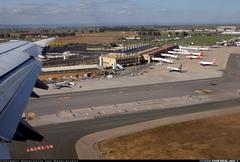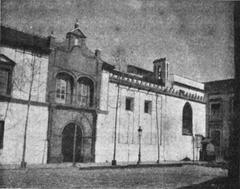
Hospital de la Santa Caridad Seville: Visiting Hours, Tickets, and Travel Guide
Date: 04/07/2025
Introduction
The Hospital de la Santa Caridad, located in the heart of Seville, is a stunning example of Spanish Baroque architecture and a monument to the city’s enduring charitable spirit. Founded in the 17th century by Miguel Mañara and the Hermandad de la Santa Caridad, the hospital was established to care for the sick and ensure dignified burials for the poor and marginalized—a mission that continues today. Visitors are captivated by masterpieces from renowned artists like Bartolomé Esteban Murillo and Juan de Valdés Leal, and by the serene courtyards that invite reflection. This guide offers comprehensive information on the hospital’s history, significance, practical visitor details, and travel tips to help you make the most of your visit (Seville Tourism; Patronato de la Santa Caridad; Museo del Prado).
Table of Contents
- Introduction
- Origins and Foundation
- Architectural and Artistic Significance
- Cultural and Social Importance
- Evolution and Preservation
- Practical Visitor Information
- Visitor Experience
- FAQs
- Conclusion
- References
Origins and Foundation
The hospital’s roots lie in the charitable brotherhood Hermandad de la Santa Caridad, established during the late Middle Ages. Its mission focused on providing Christian burials for the poor and offering care to the sick and destitute—a crucial service in a city often afflicted by epidemics and hardship (Andalucia.com). The present complex was constructed in the mid-17th century under the leadership of Miguel Mañara. Deeply moved by the suffering he witnessed, Mañara transformed the brotherhood’s activities into a lasting institution rooted in humility and service (Patronato de la Santa Caridad).
Architectural and Artistic Significance
Baroque Masterpiece
Designed by Leonardo de Figueroa, the Hospital de la Santa Caridad is an exemplar of Sevillian Baroque. Its façade features dramatic sculptural decoration and vibrant ceramic tile panels depicting saints and virtues. The building is organized around tranquil courtyards and leads to the Church of San Jorge, the artistic and spiritual heart of the complex (Seville Tourism; Andalucia.com).
Church of San Jorge
The church’s interior is lavishly adorned with gilded altarpieces, intricate woodwork, and expressive sculptures. The main altarpiece by Pedro Roldán and the polychrome figures exemplify the technical mastery of Sevillian artisans. The walls and ceilings feature elaborate stucco and gilded motifs, creating an immersive Baroque experience (visitasevilla.es).
Murillo and Valdés Leal
Murillo contributed a series of paintings illustrating the brotherhood’s commandments, such as “The Miracle of the Loaves and Fishes” and “Moses at the Rock of Horeb.” Four of his original works remain in situ; others, taken during the Napoleonic Wars, are now reproduced in the church (Museo del Prado; wikipedia.org). Valdés Leal’s haunting “In Ictu Oculi” and “Finis Gloriae Mundi” serve as powerful reminders of mortality and the imperative of charity (Museo de Bellas Artes de Sevilla).
Cultural and Social Importance
Throughout the centuries, the hospital has been a vital part of Seville’s social fabric, caring for the sick, elderly, and poor, and providing dignified burials for the unclaimed dead. The brotherhood’s statutes emphasized humility, compassion, and Christian duty—values that remain central to its mission (Patronato de la Santa Caridad). Its tradition of artistic patronage helped make Seville a center of Baroque art, and the hospital continues to inspire visitors and scholars alike.
Miguel Mañara’s life of transformation and charity became legendary, influencing literature and culture, and his tomb in the church attracts pilgrims and admirers (Andalucia.com).
Evolution and Preservation
Despite challenges during the 19th-century secularization of Spain, the hospital survived through private donations and the brotherhood’s commitment. In the 20th and 21st centuries, the site has been carefully restored and adapted, maintaining its dual role as a residence for the elderly and a monument open to the public (Seville City Council; Ministerio de Cultura y Deporte).
The hospital was declared a Bien de Interés Cultural (Asset of Cultural Interest) in 1931, underscoring its national significance. Ongoing preservation projects safeguard its artworks and architecture for future generations (Seville Tourism).
Practical Visitor Information
Visiting Hours
- Monday to Saturday: 10:00 AM – 6:30 PM
- Sunday and Public Holidays: 10:00 AM – 2:30 PM
(Please note: hours may vary on special holidays. Always check the official website for current information.)
Ticket Prices & Booking
- General Admission: €8
- Reduced Admission: €5 (students, seniors, EU citizens 18-25)
- Free Admission: Children under 16 and Seville residents
Tickets can be purchased online at the official website or on-site. Advance booking is recommended during peak seasons.
Accessibility
- Wheelchair access at the main entrance
- Adapted restrooms available
- Some historic areas may be less accessible due to preservation constraints; staff can assist as needed
Guided Tours & Special Events
- Guided tours in multiple languages can be booked in advance
- Occasional concerts and cultural events—check the official calendar for updates
Travel Tips & Nearby Attractions
- Centrally located near the Seville Cathedral, Real Alcázar, and Torre del Oro
- Easily accessible by foot, taxi, or public transport (close to bus lines C3/40 and Puerta de Jerez metro)
- Allow at least two hours for a thorough visit
- Photography is permitted in most areas (no flash or tripods; respect signage)
- Nearby cafes and plazas offer options for relaxation
Visitor Experience
Begin your visit in the tranquil central courtyard, then proceed to the Church of San Jorge, where Baroque art and architecture await. Don’t miss the old council chamber, which houses personal artifacts of Miguel Mañara, and the solemn “Patio de los Muertos” (Courtyard of the Dead), a space for reflection on the hospital’s charitable legacy.
Multilingual information panels and audio guides enrich the self-guided experience, while guided tours provide deeper historical and cultural context.
Frequently Asked Questions (FAQs)
What are the Hospital de la Santa Caridad visiting hours?
Monday to Saturday: 10:00 AM – 6:30 PM; Sundays and holidays: 10:00 AM – 2:30 PM.
How do I purchase tickets?
Tickets can be purchased on-site or in advance online via the official website.
Is the site accessible for people with disabilities?
Yes, the main areas are wheelchair accessible and adapted restrooms are available.
Are guided tours available?
Yes, available in several languages by prior booking.
Is photography allowed?
Photography is generally allowed without flash; respect restrictions in sacred or sensitive areas.
How do I get there?
Located at Calle Temprado, 3, central Seville—easily reached by public transport or on foot.
Conclusion
The Hospital de la Santa Caridad stands as one of Seville’s most significant historical and artistic landmarks—a living testament to the city’s commitment to charity and cultural excellence. With its Baroque architecture, world-class artworks, and ongoing charitable mission, it offers a profoundly moving experience for all visitors. Plan ahead by checking current visiting hours and ticket options, and consider joining a guided tour for an in-depth understanding. Its central location makes it an essential stop on any Seville itinerary.
For real-time updates, event schedules, and exclusive resources, download the Audiala app and follow us on social media.
References
- Patronato de la Santa Caridad
- Seville Tourism
- Seville City Guide
- Sevilla de Turismo - Hospital de la Caridad
- Museo del Prado - The Miracle of the Loaves and Fishes by Murillo
- Andalucia.com
- Ministerio de Cultura y Deporte
- Museo de Bellas Artes de Sevilla
- introducingseville.com
- wikipedia.org
- seville-pass.com
- seville-traveller.com
- sevillawalks.com
- visitarsevilla.com


